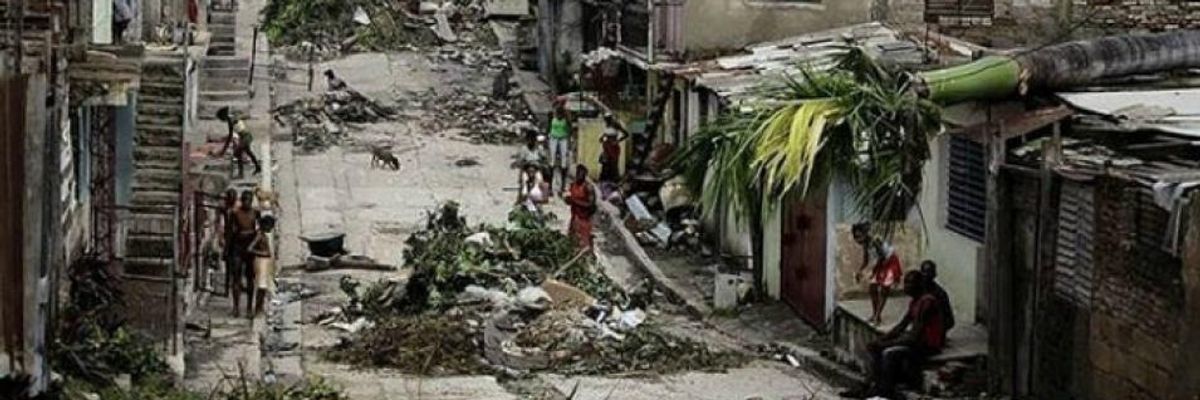I just returned from my summer research in Haiti, traveling through the South and Grand-Anse provinces, which were devastated by Hurricane Matthew overnight on October 4, 2016, barely ten months ago.
Visitors to the Grand-Anse whose only experience of Haiti is the West department, which houses Port-au-Prince, are often stunned at the level of vegetation. Referring to this typical reflex of many outsiders, anthropologist/nurse Bette Gebrian Magloire calls Matthew an "invisible disaster." From the road, it is possible to see new tin roofs, but off the main road, where most rural residents live, people fend for themselves.
I too was stunned, but by the missing trees, and by the miniscule amount of food produced. Asking someone in the Grand-Anse when they last ate tonmtonm, a local specialty made of breadfruit, often brought tears to their eyes. Long a staple, breadfruit trees, like export-oriented mangoes, could take several years to bear fruit again. Before the hurricane breadfruit sold three for 10 gourdes in local markets; this summer the price shot up 30 times to 100 gourdes ($1.50).
I wish I could also say I was stunned by the official response to the hurricane. Alas, Matthew was destined to be a forgotten disaster, in the shadow of Haiti's 2010 earthquake and overshadowed by the U.S. elections. With official UN appeals at $139 million as of November, pledges were less than one percent of aid promised following Haiti's 2010 disaster, reaching $291.3 this year, still only 1.8 percent. As of July 4, nine months after the hurricane, only 19.2% was committed.
Aside from Miami Herald reporter Jacqueline Charles' moving pieces in April and two in July, there has been almost no follow up within international media outlets. The Trump administration added insult to injury, saying that Haiti was safe for a return of 58,706 people living in the U.S. under Temporary Protected Status.
Trying to make sense of Hurricane Matthew, reports are beginning to come in from scholars such as Herns Marcelin and colleagues on the Grand-Anse, and Athena Kolbe and colleagues on the South.
I've had the fortune and responsibility to be working with Haitian graduate students in both provinces since 2015. And a board member of an organization engaging emergency response with 27 partner organizations in the South. Visiting students on a weekly basis - and visiting representatives from 6 local organizations - brought me face to face with the dignity of communities struggling to rebuild, the very occasional aid distribution faced with literally mountains of logistical challenges, and the gradual growth of root crops like yams and plantains finally able to produce.
The real disaster of Hurricane Matthew is still unfolding. In addition to the protracted famine conditions, climate change is already menacing Haitian farmers. Unseasonably heavy rains washed away many attempts at a season's crops, not once but twice since Matthew. Unpredictable weather prevents planters and their families from planning planting and harvests.
While the outside world forgot Matthew, there is a lively debate within Haiti, with many perspectives emerging. Haiti's national government formally issued a cease-and-desist order for housing projects outside of their plan at a July 22 convocation. That same day, the government also published a list of over 200 NGOs out of compliance. The Association of Mayors in Grand-Anse also issued a warning to NGOs to get with the program.
While generally critical of the response, people in affected communities have a diverse range of understandings, as three recently-published reports document. The reports were written by three Development Sciences Master's students at the Faculte d'Ethnologie, one of three State University of Haiti campuses currently closed. Last October, the students and I returned to the fieldsites where they previously conducted eight weeks of mixed method research. They again returned for follow up research in December. All three were part of this summer's research team, two returning to the same fieldsites.
Roseline Lamartiniere wrote about Abricots, an isolated coastal community in the Grand-Anse. She observed several distributions during her December research. From her observations, Lamartiniere highlighted NGOs' visibility, but also noted that the political divisions that bedogged the town the previous summer had been put away in the spirit of solidarity. Lamartiniere was joined by her research partner Heather Prentice-Walz and the latter's counterpart this year, Jamesky Blaise, in a lively community discussion on July 30.
Writing about Port-Salut, Nancy Marie Sherline Saint Louis warned about the political divisions between sections of the town, with downtown residents favorable to the Deputy (Haiti's version of the U.S. Representative) and the mayor's seksyon kominal (borough/neighborhood) siding with him. Saint Louis highlights Port-Salut's strengths residents identified, including its natural resources and beauty and the tourism and fishing trade. Among others, she recommends rebuilding upon these strengths.
Also from the South, a "Little Place Apart" of Camp-Perrin, Elkins Voltaire probes the variation in residents' evaluation of NGOs, the state, and local authorities. He argues for the importance of what he calls "humanitarian communication," that open communication and inclusion - sending a message that people are valued and reinforcing dignity - might be even more important than material resources. Voltaire quotes a resident, "If they only passed to see us, even if they did not bring anything, we would thank God." Voltaire and his U.S. partner Castelline Tilus were guests on local radio.
The three students presented their work to an attentive and engaged crowd of students, government employees, and aid workers on July 24. Ernst Mathurin, co-founder of GRAMIR, one of the longest-standing NGOs working in the Grand-Anse and co-author of the first textbook on NGOs in Haiti, moderated, and anthropologist Kaiting Jessica Hsu, with years of experience in the Grand-Anse and who translated the reports, was discussant.
Some of the main themes across all three reports are:
- Visibility - that aid brings about visibility to the NGO, and possibly division
- Communication - an essential ingredient, particularly asking residents what their priorities are
- Inclusion - that beneficiaries need to be part of the decisionmaking, and local people should be hired as well
- Solidarity - in all three towns, the first responders were the communities themselves. This needs to be supported
This disaster is still deeply felt: on Friday, the Haitian American Museum of Chicago is inaugurating a "Voices from Matthew" exhibit by Haitian artists.
Hopefully now available in English these lessons of Haiti's forgotten disaster can be learned and applied, most importantly in the still-ongoing (if drastically under-resourced) response in Haiti, but other forgotten disasters across the world.



